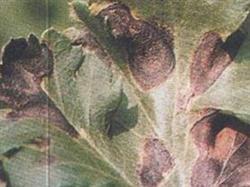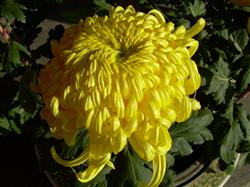Occurrence and control of chrysanthemum powdery mildew

Powdery mildew of chrysanthemum is one of the common diseases in flowers, which is distributed in the south and north of China. Powdery mildew of chrysanthemum causes poor plant growth, withered leaves and even does not blossom, seriously affecting the effect of greening and beautification and flower production; it is also harmful to melon and leaf chrysanthemum, calendula, echinacea, African chrysanthemum, Persian chrysanthemum, emerald chrysanthemum, dahlia, zinnia, rose, rose, impatiens, cherry cherry, okra, poinsettia, hollyhock, fluke, begonia, wisteria and so on. Harmful symptoms of chrysanthemum powdery mildew in the early stage of infection, yellow transparent small white powder spots appeared on the leaves, mostly on the front of the leaves, mainly harmful leaves, petioles and young stems and leaves were more likely to be infected. When the temperature and humidity are appropriate, the disease spot can be expanded rapidly and connected into a large area of white powder spot, or gray powder mold layer. In severe cases, the diseased leaves faded and yellowed; the leaves and shoots curled, deformed, premature senescence and withered; the stem bent, the new shoots stopped growing, the flowers were few and small, the plants were dwarfed, sterile or uncivilized, and even died. The pathogen and occurrence regularity of powdery mildew are powdery mildew fungi, inulinosporium, and the sexual segment is two-spore powdery mildew. The disease can occur all the year round in open field cultivation in the south and greenhouse in the north of China. The pathogen overwintered in the stump of the diseased plant or in the soil, and it was suitable for temperature and humidity in the following spring, the ascospores were cracked, ascospores were scattered, and spread and spread by airflow and wind and rain, and could be infected many times. The disease can occur from May to November, and frequently occurs from August to October. It is easy to infect the disease at 20 / 25 ℃. It is most likely to occur in high humidity, weak light, poor ventilation and temperature difference between day and night above 10 ℃. The disease was serious from September to October, mainly in the wet environment of rainy, dewy and foggy in autumn. When the air humidity is high, the ventilation is poor, and the light is insufficient, the occurrence is more serious when the plants are watered too much, the plants are too dense or under the influence of drought, and the cultivation management is poor, resulting in weak plant growth. Control methods 1. Clear garden treatment should pay attention to cutting off overdense and withered yellow leaves, pulling out diseased plants, cleaning up diseased and residual leaves, concentrated burning or deep burial, which can greatly reduce the source of pathogen infection. 2. Strengthen production management and planting should not be too dense, control soil moisture, increase ventilation and light transmission. To avoid excessive application of nitrogen fertilizer, we should apply more phosphorus and potassium fertilizer to enhance the disease resistance of plant leaves. Attention should be paid to keeping the leaves dry during watering to prevent water droplets from splashing and spreading, or high temperature and humidity, invading the host and causing re-infection. 3, drug control basin soil or seedbed, soil drug sterilization, you can use 50% thiophanate methyl and 50% thiophanate (1:1) mixture 600mur700 times liquid spray basin soil or seedbed, soil, can achieve germicidal effect. At the initial stage of the disease, the disease can be sprayed with 100x emulsion of agricultural antibiotic 120 or antibacterial B0Mel 10, or 1000 times of Ruinong wet powder or 75% thirteen morpholine emulsion, sprayed once every 10 days, and sprayed 3 times continuously to control the occurrence and spread of the disease. In particular, with 25% enemy power to remove (propiconazole) EC 20ml plus 100 kg of water spray, spray once every 15 days, continuous spray 2 Mel 3 times, the prevention and control effect is better. In addition, during the onset period, 70% methyl thiophanate wettable powder 32m 48g, or 50% methyl thiophanate wettable powder 45m 67.5g, add water 70kg, stir and spray, spray once every 7Mel 10 days, spray 2Mel 3 times in a row You can also use 1500 times of 15% trimethoprim emulsion, 800Mel 1000x solution of 70% methyl topiramate wettable powder, 300x solution of 50% polysulfide suspension, or 2000 times of 20% chlorothalonil EC or 1000 times of 75% chlorothalonil wettable powder, spraying once every 7 times every 10 days for 4 times in a row.
- Prev

Common pesticides for prevention and control of chrysanthemum diseases and insect pests
First, the main symptoms: occur in the leaves, and mostly in the lower leaves. The initial stage of the disease spot is faded green macula; after expansion, the disease spot is round to irregular, the edge is dark brown, inside grayish brown; in the later stage, the disease spot is dry and black granules appear. Second, the cause of the disease: fungal diseases. Germs live in the soil.
- Next

Cultivation and Management of Yellow Chrysanthemum
Yellow chrysanthemum is called chrysanthemum cauliflower. The leaf of chrysanthemum cauliflower plant is round, the petiole is shortened and many wheels form a chrysanthemum shape, the petiole is green, the leaf is glossy, the leaf edge is entire, the weight of single plant can reach 150 grams, the quality is good, and the flavor is better after frost. Chrysanthemum cauliflower has the effect of clearing heat, dispelling wind, detoxification and eyesight. Many friends ask about it.
Related
- Fuxing push coffee new agricultural production and marketing class: lack of small-scale processing plants
- Jujube rice field leisure farm deep ploughing Yilan for five years to create a space for organic food and play
- Nongyu Farm-A trial of organic papaya for brave women with advanced technology
- Four points for attention in the prevention and control of diseases and insect pests of edible fungi
- How to add nutrient solution to Edible Fungi
- Is there any good way to control edible fungus mites?
- Open Inoculation Technology of Edible Fungi
- Is there any clever way to use fertilizer for edible fungus in winter?
- What agents are used to kill the pathogens of edible fungi in the mushroom shed?
- Rapid drying of Edible Fungi

